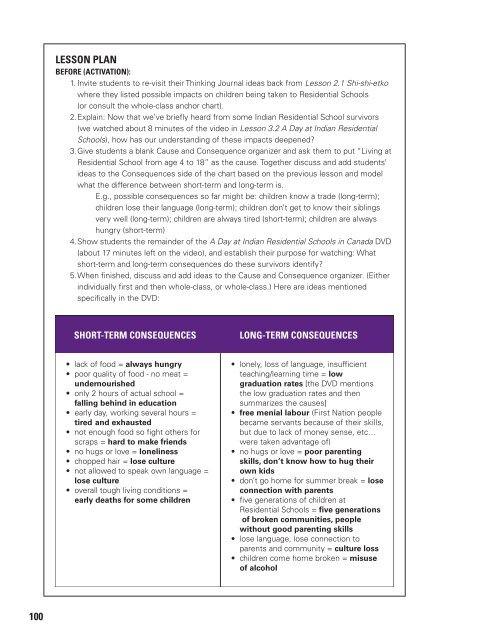Residential Residential
Residential_School
Residential_School
You also want an ePaper? Increase the reach of your titles
YUMPU automatically turns print PDFs into web optimized ePapers that Google loves.
LESSON PLAN<br />
BEFORE (ACTIVATION):<br />
1. Invite students to re-visit their Thinking Journal ideas back from Lesson 2.1 Shi-shi-etko<br />
where they listed possible impacts on children being taken to <strong>Residential</strong> Schools<br />
(or consult the whole-class anchor chart).<br />
2. Explain: Now that we’ve briefly heard from some Indian <strong>Residential</strong> School survivors<br />
(we watched about 8 minutes of the video in Lesson 3.2 A Day at Indian <strong>Residential</strong><br />
Schools), how has our understanding of these impacts deepened?<br />
3. Give students a blank Cause and Consequence organizer and ask them to put “Living at<br />
<strong>Residential</strong> School from age 4 to 18” as the cause. Together discuss and add students’<br />
ideas to the Consequences side of the chart based on the previous lesson and model<br />
what the difference between short-term and long-term is.<br />
E.g., possible consequences so far might be: children know a trade (long-term);<br />
children lose their language (long-term); children don’t get to know their siblings<br />
very well (long-term); children are always tired (short-term); children are always<br />
hungry (short-term)<br />
4. Show students the remainder of the A Day at Indian <strong>Residential</strong> Schools in Canada DVD<br />
(about 17 minutes left on the video), and establish their purpose for watching: What<br />
short-term and long-term consequences do these survivors identify?<br />
5. When finished, discuss and add ideas to the Cause and Consequence organizer. (Either<br />
individually first and then whole-class, or whole-class.) Here are ideas mentioned<br />
specifically in the DVD:<br />
SHORT-TERM CONSEQUENCES<br />
LONG-TERM CONSEQUENCES<br />
• lack of food = always hungry<br />
• poor quality of food - no meat =<br />
undernourished<br />
• only 2 hours of actual school =<br />
falling behind in education<br />
• early day, working several hours =<br />
tired and exhausted<br />
• not enough food so fight others for<br />
scraps = hard to make friends<br />
• no hugs or love = loneliness<br />
• chopped hair = lose culture<br />
• not allowed to speak own language =<br />
lose culture<br />
• overall tough living conditions =<br />
early deaths for some children<br />
• lonely, loss of language, insufficient<br />
teaching/learning time = low<br />
graduation rates [the DVD mentions<br />
the low graduation rates and then<br />
summarizes the causes]<br />
• free menial labour (First Nation people<br />
became servants because of their skills,<br />
but due to lack of money sense, etc…<br />
were taken advantage of)<br />
• no hugs or love = poor parenting<br />
skills, don’t know how to hug their<br />
own kids<br />
• don’t go home for summer break = lose<br />
connection with parents<br />
• five generations of children at<br />
<strong>Residential</strong> Schools = five generations<br />
of broken communities, people<br />
without good parenting skills<br />
• lose language, lose connection to<br />
parents and community = culture loss<br />
• children come home broken = misuse<br />
of alcohol<br />
100


